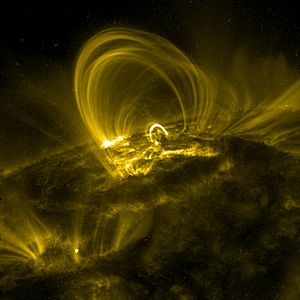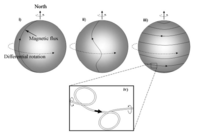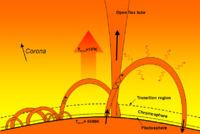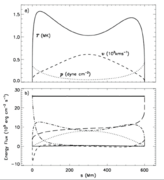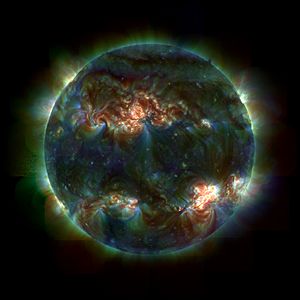Coronal loop facts for kids
A coronal loop is a bright, arch-shaped structure found in the Sun's outer atmosphere. Think of it like a giant glowing rainbow made of hot, electrically charged gas called plasma. These loops are held in place by the Sun's powerful magnetic fields. They start and end at two points on the Sun's surface, called photosphere, and reach up into the corona, which is the outermost layer of the Sun's atmosphere.
Coronal loops can form and disappear quite quickly, from a few seconds to several days. They can be very long, stretching from about 1 to 1,000 million meters (that's 1,000 to 1,000,000 kilometers!). You often see them in areas where the Sun's magnetic fields are very strong, especially near active regions and sunspots. The number of coronal loops we see changes with the Sun's 11-year solar cycle.
Contents
How Coronal Loops Form
The Sun is like a giant ball of hot, moving plasma. This movement creates electric currents, which then make very strong magnetic fields deep inside the Sun. This process is called the solar dynamo. These magnetic fields often form closed loops.
A coronal loop appears when one of these curved magnetic field lines pushes out from the Sun's visible surface, the photosphere, and into the Sun's atmosphere.
Inside a coronal loop, the charged particles of the plasma (like electrons and ions) are trapped. They can only move along the magnetic field lines, spiraling around them. This means the plasma can't easily escape sideways from the loop; it's "frozen-in" to the magnetic field.
The two "footpoints" of a coronal loop are where the magnetic field lines enter and leave the Sun's surface. These footpoints are anchored to the Sun's surface and move as the Sun rotates. Often, these footpoints are cooler than the surrounding areas because the strong magnetic field stops heat from reaching the surface. These cooler spots look dark and are called sunspots. So, sunspots often appear under coronal loops and usually come in pairs, like the North and South poles of a magnet.
Coronal loops come in many sizes, from about 10 kilometers to 10,000 kilometers long. They also have different temperatures:
- Cool loops: Below 1 million degrees Celsius (1 megakelvin).
- Warm loops: Around 1 million degrees Celsius.
- Hot loops: Above 1 million degrees Celsius.
Each temperature category glows at different light wavelengths, which helps scientists study them.
Sometimes, magnetic fields don't form closed loops but extend far out into space. These are called open magnetic flux tubes and are responsible for the solar wind, which is a stream of particles flowing from the Sun.
-
A diagram of the lower corona and transition region, where many different sizes of coronal loops can be seen.
Where Coronal Loops Are Found
Coronal loops can be found in both active and quiet parts of the Sun's surface. Active regions are small but very busy areas where most of the Sun's activity happens, like flares and coronal mass ejections (huge bursts of plasma). This is because the magnetic fields are very strong there. Active regions produce most of the heat in the corona.
Plasma Movement in Loops
Scientists have seen strong movements of plasma inside coronal loops. For example, some observations show plasma moving at speeds of 5 to 16 kilometers per second, while others detect speeds of 15 to 40 kilometers per second. Very fast plasma speeds, up to 40 to 60 kilometers per second, have also been measured.
How We Observe Coronal Loops
For a long time, scientists studied the Sun using telescopes on Earth or during eclipses. But to get a clearer view of the corona, they needed to send telescopes into space, away from Earth's atmosphere.
Early Space Observations (Before 1991)
Early rocket missions, like Aerobee and Skylark, successfully measured the Sun's extreme ultraviolet (EUV) and X-ray light. However, these rockets could only stay in space for a short time. Later, satellites like the Orbiting Solar Observatory series (OSO-1 to OSO-8), Skylab, and the Solar Maximum Mission (which lasted almost a full solar cycle from 1980 to 1989) collected much more data over longer periods.
Modern Space Observations (1991–Present)
A big step forward happened in August 1991 with the launch of the Yohkoh spacecraft. For 10 years, Yohkoh completely changed how we saw X-rays from the Sun. One of its instruments, SXT, observed X-ray-emitting coronal loops. It could see X-rays in a specific energy range and capture very detailed images quickly. This data was great for comparing with later observations from TRACE.
The next major mission was the Solar and Heliospheric Observatory (SOHO), launched in December 1995. SOHO was so successful that its mission was extended, allowing it to observe a complete 11-year solar cycle. SOHO has 12 instruments, all designed to study the Sun's atmosphere. Its Extreme ultraviolet Imaging Telescope (EIT) is especially important for observing coronal loops. EIT takes pictures of different layers of the Sun's atmosphere using various wavelengths of EUV light.
In April 1998, the Transition Region and Coronal Explorer (TRACE) spacecraft was launched. TRACE works with SOHO to give an amazing view of the Sun, especially during the active phase of the solar cycle. TRACE takes very detailed, high-resolution images of coronal structures, while SOHO provides a wider, global view of the Sun. This combination helps scientists track how coronal loops change over time. TRACE uses special filters to see the light from quiet coronal loops.
See also
- Solar spicule
- Solar prominence
- Coronal hole


